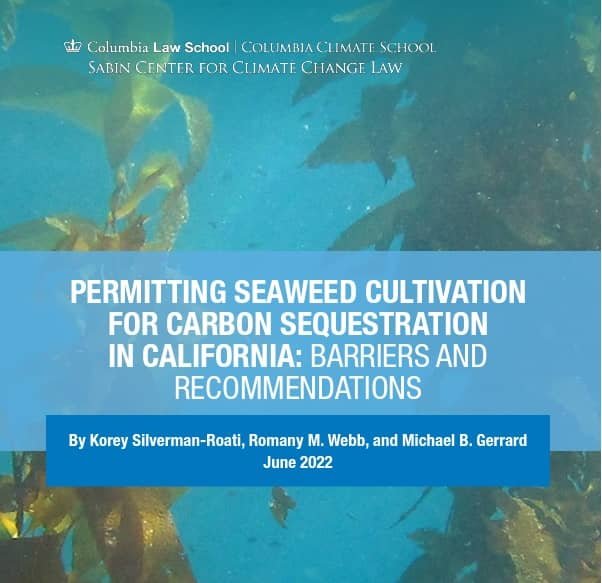by Korey Silverman-Roati, Climate Law Blog
Growing interest in using the oceans to enhance removal of carbon dioxide from the atmosphere has in turn spurred more interest in seaweed cultivation. A recent report by the National Academies of Sciences, Engineering, and Medicine (NASEM) concluded that the “ocean holds great potential for uptake and longer-term sequestration of” carbon dioxide. The report analyzed a number of ocean-based techniques and concluded that seaweed cultivation could be a “compelling” ocean carbon dioxide removal (CDR) strategy.

Today, the Sabin Center released a white paper exploring barriers to seaweed permitting for carbon sequestration in California. A previous paper discussed international, and U.S. federal and state laws applicable to seaweed cultivation. That paper was part of a series of white papers exploring the legal issues associated with a number of ocean-based CDR strategies, including ocean alkalinity enhancement and artificial upwelling and downwelling.
Seaweed cultivation refers to the growing of kelp and other macroalgae that uptake carbon dioxide as they grow. Seaweed is grown mostly near the shore, and stores the carbon dioxide it has drawn in principally in its biomass, with some carbon dioxide also stored in the sediment below where it is grown. To offset emissions, cultivated seaweed could be used to replace more greenhouse gas-intensive products like animal-based foods, or in bioenergy systems. Seaweed could also be sunk in the deep sea for the purposes of carbon sequestration.
Seaweed cultivation off the California coast is still in nascent stages, with only two commercial, open-water seaweed farms in California waters at the time of writing, but farmers have expressed growing interest in expanding the practice.
One barrier to expanding seaweed cultivation in California is a complex, costly, and time-consuming lease and permitting process. Other states in the U.S., namely Maine and Alaska, have permitting systems designed to be more supportive of seaweed cultivation. This paper explores possible reforms to streamline California’s permitting process, while maintaining appropriate environmental and other safeguards.
Permitting for seaweed cultivation in California involves approvals from a considerable number of state and federal agencies, pursuant to state and federal land use and environmental laws. The process can effectively be split into three parts – (1) obtaining a state water bottom lease; (2) completing an environmental review ; and (3) completing a multi-agency permitting process to allow seaweed ocean farming inside of the lease area. Due to the multiple steps involved, the permitting process for seaweed farming operations can be costly and may take several years to complete.
California policymakers may be able to draw lessons from less costly and quicker permitting systems in Maine and Alaska. Alaska offers permittees a joint agency aquatic farming application that can be used to obtain required state approvals, including the site lease, farm operation permit, and special area permit. The consolidated joint agency approach in Alaska is in part responsible for faster processing times than in California. Maine offers seaweed farmers three forms of permits, each with different levels of complexity in the permitting process. These include experimental leases and limited purpose licenses that give farmers flexibility, allowing for experimentation in location and methods.
The paper released today concludes with five recommended changes to the lease and permitting process in California. Ideally, these could serve to lessen or remove unnecessary roadblocks to permitting, while still maintaining important environmental and other review of prospective projects. The recommendations, discussed in more detail in the paper, are to:
Stay Always Informed
Join our communities to instantly receive the most important news, reports, and analysis from the aquaculture industry.
- Streamline the permit application process;
- Develop public interest criteria that balance climate goals and environmental stewardship;
- Prioritize state water bottom leases for seaweed farms in designated areas and prepare program environmental impact reports;
- Create a new categorical exemption from CEQA; and
- Create experimental permits
Reference (open access):
Korey Silverman-Roati, Romany M. Webb & Michael B. Gerrard. 2022. Permitting Seaweed Cultivation for Carbon Sequestration in California: Barriers and Recommendations, (2022).
Editor at the digital magazine AquaHoy. He holds a degree in Aquaculture Biology from the National University of Santa (UNS) and a Master’s degree in Science and Innovation Management from the Polytechnic University of Valencia, with postgraduate diplomas in Business Innovation and Innovation Management. He possesses extensive experience in the aquaculture and fisheries sector, having led the Fisheries Innovation Unit of the National Program for Innovation in Fisheries and Aquaculture (PNIPA). He has served as a senior consultant in technology watch, an innovation project formulator and advisor, and a lecturer at UNS. He is a member of the Peruvian College of Biologists and was recognized by the World Aquaculture Society (WAS) in 2016 for his contribution to aquaculture.




